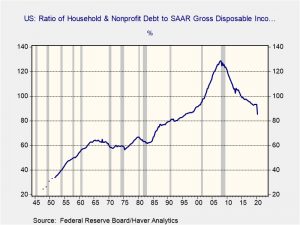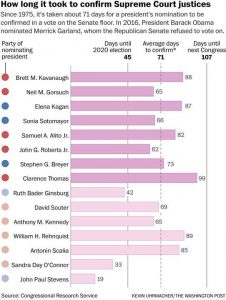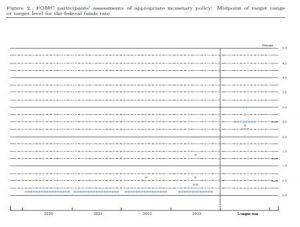by Bill O’Grady, Thomas Wash, and Patrick Fearon-Hernandez, CFA
[Posted: 9:30 AM EDT] | PDF
Our Daily Comment today provides a brief introduction to tonight’s presidential debate, the anticipation of which could keep a lid on the markets throughout the day. We also discuss several geopolitical tensions involving Eastern Europe, as well as the latest developments related to the coronavirus epidemic.
U.S. Elections: President Trump and Joe Biden will meet face to face tonight in the first of three scheduled debates before the presidential election. The action starts at 9:00 pm ET and is scheduled to last an hour and a half. With Biden narrowly leading in many key polls and prediction markets, we would expect him to work hard at maintaining a calm, presidential air while attacking Trump on issues like the coronavirus pandemic, income and social inequalities, and the president’s tax records. We would expect Trump to hammer away at Biden’s age and the left wing of the Democratic Party. If the result is perceived to be a draw, the event could have little or no discernible impact on the financial markets. However, if one side or the other scores a body blow or suffers a major gaffe, markets could react significantly on Wednesday. In fact, if that happens, the resulting market moves could indicate what to expect over the coming month as the election dynamics play out.
United States-Russia: As talks over extending the last remaining U.S.-Russia strategic arms control agreement remain deadlocked, the Trump administration has reportedly asked the military to assess how quickly it could pull U.S. nuclear weapons out of storage and load them onto bombers and submarines if the treaty expires in February. The request was part of a strategy to heap pressure on Russia in renegotiating the New START treaty ahead of the U.S. election.
European Union: Amid negotiations over the EU’s long-term budget and its proposed new €750 billion pandemic relief fund, Germany proposed rules that, in some circumstances, would suspend disbursements to countries violating the bloc’s rules on judicial independence and respect for democracy. However, several northern European member states criticized the move as too weak, even though it is likely to be too intrusive for eastern members like Hungary and Poland. The prolonged impasse is important because it could undermine the relief fund’s massive new mutualized EU debt obligations backed by the full faith and credit of the member countries.
France-Belarus: In his visit to the Baltic states of Latvia and Lithuania this week, French President Macron met with exiled Belarussian opposition leader Svetlana Tikhanovskaya and promised to help negotiate the release of other opposition leaders imprisoned by Belarussian President Aleksander Lukashenko. The intervention into Belarus, which Russian President Putin considers to be in Russia’s rightful sphere of interest, is an additional sign that Macron may be giving up on his efforts to draw Europe closer to Moscow.
- Macron also promised to help shield the Baltic states from Russian cyberattacks and disinformation campaigns, and he has condemned Russia’s apparent poisoning of opposition leader Alexei Navalny (one senior French official claimed the use of a chemical weapon against him crossed “a red line”). All in all, the move reflects Macron’s ongoing effort to bolster French influence in international relations.
- Meanwhile, Russian President Vladimir Putin is using the Belarussian crisis to press Lukashenko for the right to put a Russian military bases on Belarusian territory.
Azerbaijan-Armenia-Turkey: New reporting indicates Turkey has been facilitating the Azeri government’s fight against rebels in its ethnic Armenian enclave of Nagorno-Karabakh. According to the BBC, the Turkish assistance includes military equipment, military advisors, and transporting in Syrian mercenaries to help in the fight. If so, it marks another aggressive, risky new international move by President Erdogan to assert Turkey into the region’s politics (for a fuller discussion of Erdogan’s policies, see our latest WGR, published yesterday). That move is likely to irritate Russian President Putin, who considers both Armenia and Azerbaijan as important allies, and he prefers they maintain peaceful relations. Even though the UN Security Council is scheduled to discuss the conflict later today, the fighting could also worry oil markets, as it could endanger supplies from the Caspian fields.
Precious Metals Market: An article in today’s Wall Street Journal offers a nice overview of the forces pushing up gold prices this year. Despite the recent pullback in precious metals prices, we continue to believe that factors like extremely low interest rates and expansive fiscal policy should be bullish for gold and silver in the coming years.
COVID-19: Official data show confirmed cases have risen to 33,401,514 worldwide, with 1,002,676 deaths and 23,183,669 recoveries. In the United States, confirmed cases rose to 7,150,165, with 205,091 deaths and 2,794,608 recoveries. Here is the interactive chart from the Financial Times that allows you to compare cases and deaths among countries, scaled by population.
Virology
- Confirmed U.S. infections rose by only about 33,000 yesterday, but the seven-day average remained well above 40,000. The seven-day average of daily deaths remained at approximately 750. New cases continue to surge in the Upper Midwest, especially in North Dakota, South Dakota, and Wisconsin, as well as in parts of New York City. Overseas, several days of lower infection and death figures in India raised hopes that the pandemic may be moderating in that country.
- The World Health Organization has announced plans to make 120 million inexpensive COVID-19 antigen tests available to lower and middle-income countries, seeking to limit the spread of coronavirus in the developing world.
- As a reminder that not all of the dozens of vaccines under development will face smooth sailing, Inovio Pharmaceuticals (INO, 12.14) was forced to delay the planned Phase 2/3 trial of its compound because of concerns raised by the FDA. The company suggested the concerns don’t relate to the vaccine itself, which would be the first synthetic DNA vaccine ever brought to market, but rather to the delivery equipment required to inject it. Nevertheless, the setback drove the company’s stock down sharply yesterday, even as most of the market was surging.
Economic Impacts
- United Airlines (UAL, 35.94) said its pilots union narrowly agreed to operating efficiencies that would reduce the number of layoffs the carrier must make if no additional federal financial aid is provided.
- According to the company, total compulsory layoffs can now be held to just 12,000 non-pilot staff members, compared with 16,000 pilots and non-pilots planned previously and 36,000 initially projected in July.
- The dramatic revision to planned layoffs could mean United is using the pandemic and the threat of job losses to wring concessions out of organized labor. We’ll be watching closely to see if that might be happening in other sectors as well.
- A report by professional services firm BDO indicates retail bankruptcies, liquidations, and store closings in the U.S. reached record numbers in the first half of 2020, as the pandemic accelerated industry changes like the shift to online shopping.
- Meanwhile, Manhattan office employees are returning to work at a much slower pace than those in most other major U.S. cities, raising the risk that New York faces a more protracted and painful recovery from the coronavirus pandemic than much of the rest of the country.
U.S. Policy Response
- Democratic leaders in the House of Representatives unveiled a $2.2 trillion pandemic relief bill that could come to a vote as early as Thursday. According to press reports, Speaker Pelosi and Treasury Secretary Mnuchin have already discussed the proposal last night, and they are scheduled to discuss it again this morning. Even if the measure passes the House, it is likely to be blocked in the Senate by Republicans opposed to further big increases in the budget deficit. The Democratic leadership in the House may not really want the bill passed into law anyway, as it would give President Trump the opportunity to claim a fiscal victory just before the election.
- In any case, press reports indicate that key components of the new House bill would:
- Provide a new round of direct stimulus checks in the amount of $1,200 per taxpayer and $500 per dependent;
- Restore the supplemental federal unemployment benefit of $600 per week that expired at the end of July;
- Increase food stamp benefits by 15%;
- Extend the Paycheck Protection Program to encourage firms to keep employees on their payrolls;
- Provide $436 billion in financial aid to state and local governments; and,
- Provide $28 billion in funding for vaccinations.
- Even though the proposal isn’t likely to become law, the fact that Speaker Pelosi and Secretary Mnuchin are actively in discussion may offer some encouragement that further fiscal support is possible. That is likely to be positive for risk assets in the near term.
- In any case, press reports indicate that key components of the new House bill would:





